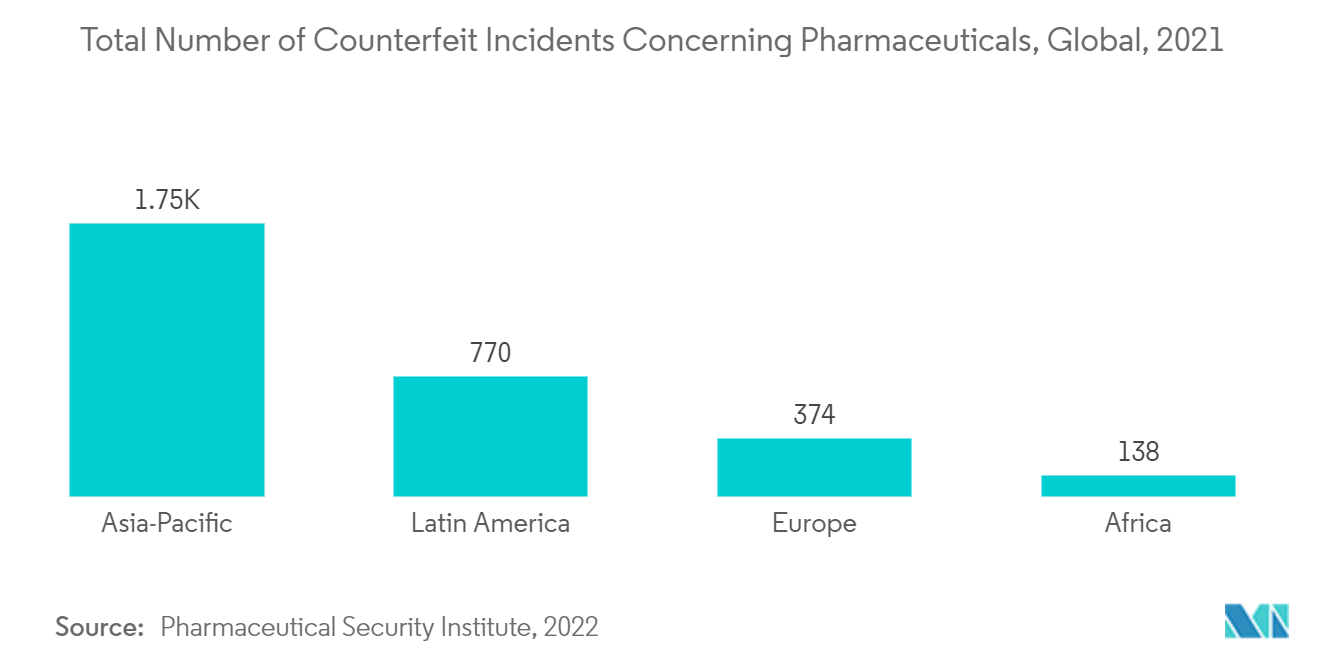Market Trends of Counterfeit Drug Detection Device Industry
This section covers the major market trends shaping the Counterfeit Drug Detection Device Market according to our research experts:
RFID Technology Segment Dominates the Market and is Expected to Continue to do so During the Forecast Period
The pharmaceutical industry uses RFID technologies to increase visibility across the value chain and track falsified drugs. The rising number of counterfeit incidents and drug recalls forced the government to reframe drug quality and take strict measures to make QR codes or RFID tags mandatory on active pharmaceutical ingredients and products due to safety and tracking purposes, which are likely to boost the growth of RFID in drug tracing systems in the coming years.
As per the report released by ASPA in March 2022, instances of substandard and falsified (SF) medical items surged by about 47% between 2020 and 2021, driven by the COVID-19 pandemic. According to an article published by the NCBI, in 2022, Valsartan was recalled due to identified contamination with N-nitroso dimethylamine (NDMA), a potentially cancerogenic substance, resulting from unintended changes in the manufacturing process in China. Valsartan is a long-term medication in patients with high blood pressure and heart diseases, which causes carcinogenic effects.
Similarly, due to nitrosamine impurities, losartan and hydrochlorothiazide were also recalled from the market. Furthermore, the introduction of next-generation RFID tags and readers is being efficiently used by drug manufacturers and wholesalers in the pharmaceutical industry to prevent medical errors and increase the safety of individualized medicinal products. Thus, the rising number of counterfeit drugs and drug recalls increased the demand for using detection technologies in drug tracing and tracking systems in the pharmaceutical industry. Therefore, the market segment is expected to surge over the forecast period.

North America is Expected to Hold Significant Market Share in the Forecast Period
North America is anticipated to hold the major market share over the forecast period, owing to the increasing risks from substandard and falsified drugs and stringent regulatory frameworks.
The rising incidence of drug counterfeiting in large pharmaceutical and biopharmaceutical companies is the key factor driving the growth of RFID technology in the market. For instance, in December 2020, Janssen Pharmaceutical was notified that counterfeit SYMTUZA had been distributed to over three pharmacies in the United States. The use of RFID is high in supply chain monitoring for tracking assets in real time. Thus, such instances are likely to drive the growth of counterfeit drug detection devices in the pharmaceutical market in the region. Moreover, as per an article published in May 2022 by the Conversation, counterfeiting operations involved tens of millions of pills, more than 1,000 kg (2,200 lbs) of active ingredient powder in the United States, and hundreds of millions of dollars in sales. Unfortunately, with over 11,000 rogue pharmacy sites selling drugs on the internet, these actions barely scratch the surface. The FDA's Office of Criminal Investigations conducts and coordinates criminal investigations into manufacturers and individuals violating federal drug laws. Overall, in 64.6% of cases, the products were sold over the internet, and in 84.6% of the enforcement actions taken, they were obtained without a prescription.
Moreover, the companies developing and launching RFID technologies and systems contribute to the market's growth. For instance, in October 2020, Sandoz partnered with Kit Check, offering artificial intelligence and radio frequency identification medication management technology. Sandoz introduced two RFID-tagged injectable products in the United States under this partnership.
Thus, the market is expected to witness significant growth during the forecast period due to the abovementioned factors.


